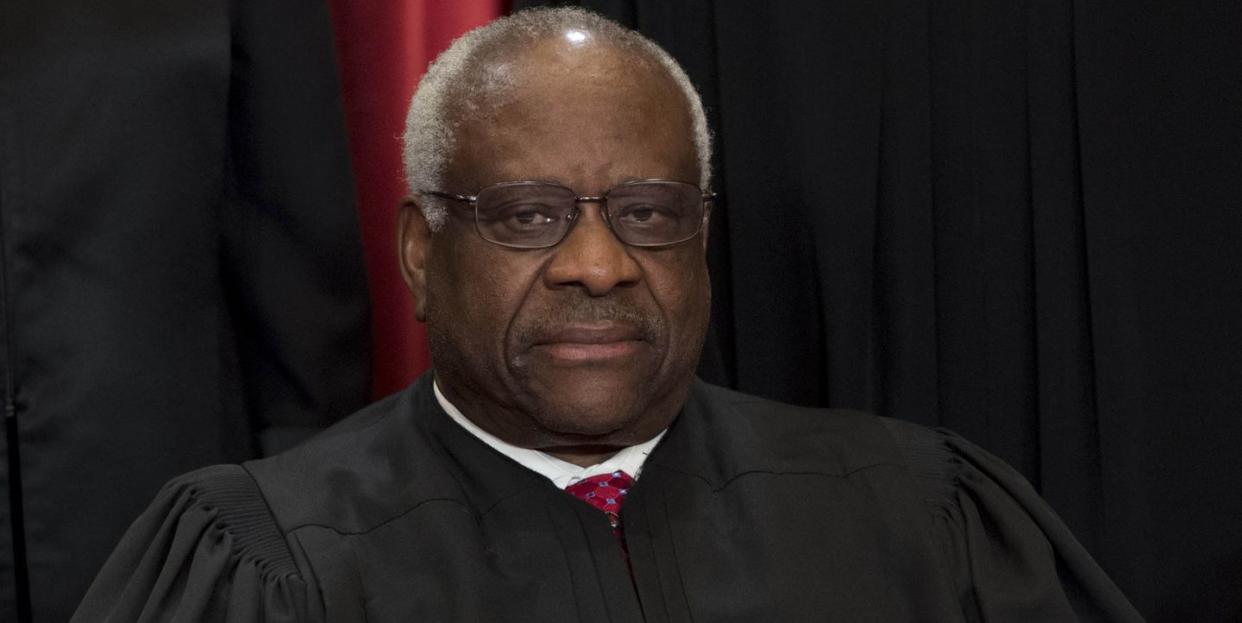Clarence Thomas Just Left Another Landmine, This Time in First Amendment Law

Clarence Thomas, layer of land mines in settled law, has managed to do it again. Perhaps that's going to be his most lasting legacy as part of the Trumpist Supreme Court: setting the explosives in place to be detonated later by whatever larval Scalias are currently gestating in the greenhouses and terrariums of the Federalist Society.
(And, it should be noted, Thomas is not alone in placing IEDs in American law that are guaranteed to detonate some day. As Ian Millhiser points out, Justice Neil Gorsuch buried one in another case that might well take out the entire administrative apparatus of the executive branch as it has developed since the New Deal, if and when the Court gets a case that will touch the device off.)
On Thursday, the Supreme Court decided, in the case of American Legion v. American Humanist, that a 40-foot cross erected on public lands in Maryland as a memorial to the dead of World War I was not in violation of the Establishment Clause of the First Amendment. Justice Samuel Alito delivered the opinion of the 7-2 majority, an opinion that seems to be based on the long-held constitutional theory of What's The Big Deal Now?
"The cross is undoubtedly a Christian symbol, but that fact should not blind us to everything else that the Bladensburg Cross has come to represent. Destroying or defacing the cross that has stood undisturbed for nearly a century would not be neutral and would not further the ideals of respect and tolerance embodied in the First Amendment."
This, despite the fact that this particular monument has a specifically Christian intent, and has had one since it was built, as Justice Ruth Bader Ginsburg noted in her dissent.
The Peace Cross is no exception. That was evident from the start. At the dedication ceremony, the keynote speaker analogized the sacrifice of the honored soldiers to that of Jesus Christ, calling the Peace Cross "symbolic of Calvary, where Jesus was crucified. Local reporters variously described the monument as "a mamoth cross, a likeness of the cross of Calvary, as described in the Bible," "a monster cross," and "a huge sacrifice cross." The character of the monument has not changed with the passage of time.
Meanwhile, Justice Thomas concurred in the decision but made it quite plain that he didn’t believe that the opinion took matters far enough into the 19th Century for his liking. His concurring opinion refers to as “debunked” the so-called “Lemon” test, a standard devised by the Court in the 1971 case of Lemon v. Kurtzman whereby Establishment Clause cases are judged by a three-pronged standard. Among other things, the Lemon test has been helpful in keeping Creationist nonsense out of public school curriculums. Conservative jurists, especially those of the theocratic variety, hate it.

But Thomas went ever further. I may be wrong but, in his opinion, he seems to be saying that the Establishment Clause itself - and, by extension, all First Amendment protections - extend to the states only insofar as the actions of the state legislatures.
The Establishment Clause states that “Congress shall make no law respecting an establishment of religion.” The text and history of this Clause suggest that it should not be incorporated against the States. Even if the Clause expresses an individual right enforceable against the States, it is limited by its text to “law[s]” enacted by a legislature, so it is unclear whether the Bladensburg Cross would implicate any incorporated right. And even if it did, this religious display does not involve the type of actual legal coercion that was a hall- mark of historical establishments of religion. Therefore, the Cross is clearly constitutional.
This is sort of a wowser. And it’s going to sit there in the law until a state legislature subcontracts the job of abridging fundamental constitutional guarantees to some ambitious governor or, worse, some local power-broker or business elite. Good luck associating freely if that happens.
Oh, wait. It’s already happening in South Dakota, as the American Civil Liberties Union has come to warn us.
In this atmosphere, South Dakota enacted a new law last week, the Riot Boosting Act. The law seeks to suppress protests before they even start and prohibits people from engaging in full-throated advocacy. It does so by creating a new, ambiguous term: “riot boosting.” If you’re wondering what that means, so is everyone else, including those who want to speak out. And that’s a big problem. The new law gives the state the authority to sue individuals and organizations for “riot boosting,” but it does not clearly describe what speech or conduct it considers to be “riot boosting.” The law is written so broadly that even a tweet encouraging activists to “Join a protest to stop the pipeline and give it all you’ve got!” could be interpreted as “riot-boosting” should a fight break out at the protest. The law joins two existing state criminal laws that also target such speech, meaning that advocacy could now result in up to 25 years of prison time, fines, or civil penalties - or a combination of all three.
Boom.
Respond to this post on the Esquire Politics Facebook page here.
('You Might Also Like',)

